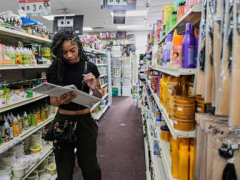ATLANTA — Before the oppressive summer heat descends on Atlanta, therapist Brittanee Sims usually gets her thick, curly hair braided at a salon to preserve her healthy mane.
But it’s more expensive this year. So she’ll only pay for her teenage daughter and son to get their summer hairdos. Not having braided hair “creates more of a hassle for everything,” said Sims, who counts herself among the tens of millions of women that regularly spend on the Black hair care industry.
Now, she said, she has to “go home and figure out what I’m gonna do to my hair in the morning, after I went to the gym and it’s messed up with sweating and frizz.”
President Donald Trump’s tariffs are driving up prices for products many Black women consider essential, squeezing shoppers and stylists even more as they grapple with inflation and higher rents. Much of the synthetic braiding hair, human hair for extensions, wigs and weaves, styling tools, braiding gel and other products is imported from or has packaging from China, which was subject to a combined 145% tariff in April. India also is a major global source of human hair.
Many Black women have hair types and workplace-favored styles that require careful attention, and they can spend hundreds of dollars at salons each month on extensions, weaves, wigs and braids. The Associated Press spoke with several Black hair industry experts, beauty supply store owners, and wholesale companies, as well as nearly two dozen Black stylists and braiders, some of whom may have to raise prices even as business has slowed.
On Thursday, a federal appeals court reinstated most of Trump’s tariffs on imported goods after they were blocked the day before by a three-judge panel of the U.S. Court of International Trade.
Earlier this month, the United States agreed to drop the 145% tax on goods imported from China to 30% while the two economic superpowers negotiate new trade agreements. Imports from most other countries face baseline tariff rates at 10%.
Regardless, the next few months “are already shot” for many items, said Marty Parker, a University of Georgia business professor and supply chain expert who worked in the hair care industry. The costs companies have been facing at ports are making their way down to consumers, supply shortages are getting worse, and it’s unclear what will happen if negotiations break down.
“Prices go up very fast and come down very slow,” Parker said.
Some stylists said they’re seeing fewer clients because prices are going up for virtually everything.
Atlanta stylists are paying more for hair from China. Atlanta stylist Yana Ellis, who also sells products like wigs, paid an extra $245 in shipping for 52 bundles of hair in March compared to 40 bundles in December. AaNiyah Butler said her shipping costs for human hair more than doubled from February to May. And Dajiah Blackshear found in early May that a beauty supply store raised the cost of the kind of hair she’s used for years by $100.
The store owner said he may have to stop selling that brand of hair because it went up so much. Similar





